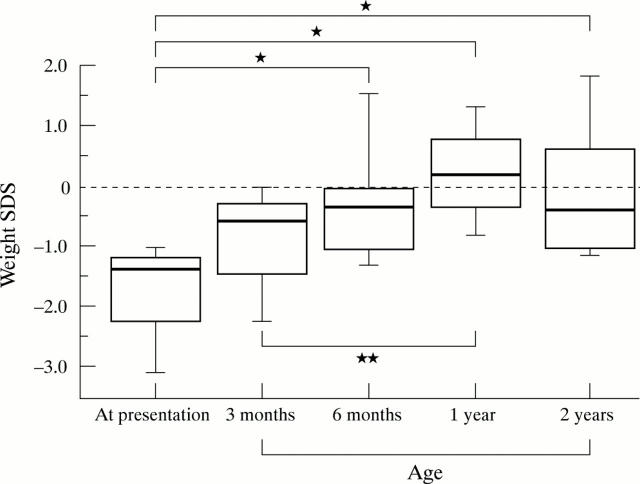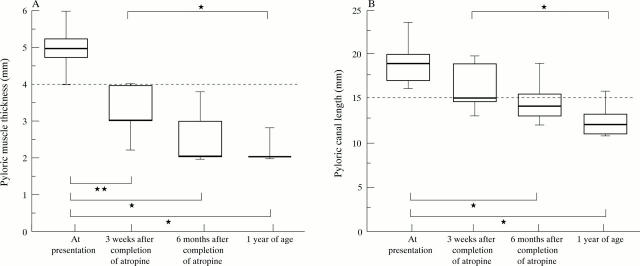Abstract
Aims: To assess the efficacy of a new regimen of intravenous atropine treatment for infantile hypertrophic pyloric stenosis (IHPS) with special reference to regression of pyloric hypertrophy.
Methods: Atropine was given intravenously at a dose of 0.01 mg/kg six times a day before feeding in 19 patients with IHPS diagnosed from radiographic and ultrasonographic findings. When vomiting ceased and the infants were able to ingest 150 ml/kg/day formula after stepwise increases in feeding volume, they were given 0.02 mg/kg atropine six times a day orally and the dose was decreased stepwise.
Results: Of the 19 infants, 17 (89%) ceased projectile vomiting after treatment with intravenous (median seven days) and subsequent oral (median 44 days) atropine administration. The remaining two infants required surgery. No significant complications were encountered. Ultrasonography showed a significant (p < 0.05) decrease in pyloric muscle thickness, but no significant shortening of the pyloric canal after completion of the atropine treatment. The patients exhibited failure to thrive at presentation, but were thriving at 6 months of age (p < 0.01).
Conclusions: This atropine therapy resulted in satisfactory clinical recovery. Pyloric muscle thickness was significantly reduced.
Full Text
The Full Text of this article is available as a PDF (132.3 KB).
Figure 1 .
Serial changes in weight standard deviation scores (SDS) in patients successfully treated with atropine. Box, interquartile range; horizontal bar, median; whiskers, 10th and 90th centile. *p < 0.01, **p < 0.05.
Figure 2 .
Serial changes in pyloric muscle thickness (A) and pyloric canal length (B) of patients successfully treated with atropine. Box, interquartile range; horizontal bar, median; whiskers, 10th and 90th centile. *p < 0.01, **p < 0.05.
Selected References
These references are in PubMed. This may not be the complete list of references from this article.
- BENSON C. D., LLOYD J. R. INFANTILE PYLORIC STENOSIS. A REVIEW OF 1,120 CASES. Am J Surg. 1964 Mar;107:429–433. doi: 10.1016/0002-9610(64)90209-0. [DOI] [PubMed] [Google Scholar]
- Berglund G., Rabo E. A long-term follow-up investigation of patients with hypertrophic pyloric stenosis-with special reference to the physical and mental development. Acta Paediatr Scand. 1973 Mar;62(2):125–129. doi: 10.1111/j.1651-2227.1973.tb08078.x. [DOI] [PubMed] [Google Scholar]
- Brain A. J., Roberts D. S. Who should treat pyloric stenosis: the general or specialist pediatric surgeon? J Pediatr Surg. 1996 Nov;31(11):1535–1537. doi: 10.1016/s0022-3468(96)90172-4. [DOI] [PubMed] [Google Scholar]
- CORNER B. D. Hypertrophic pyloric stenosis in infancy treated with methyl scopolamine nitrate. Arch Dis Child. 1955 Aug;30(152):377–386. doi: 10.1136/adc.30.152.377. [DOI] [PMC free article] [PubMed] [Google Scholar]
- Hulka F., Harrison M. W., Campbell T. J., Campbell J. R. Complications of pyloromyotomy for infantile hypertrophic pyloric stenosis. Am J Surg. 1997 May;173(5):450–452. doi: 10.1016/S0002-9610(97)00075-5. [DOI] [PubMed] [Google Scholar]
- JACOBY N. M. Pyloric stenosis: selective medical and surgical treatment. A survey of sixteen years' experience. Lancet. 1962 Jan 20;1(7221):119–121. doi: 10.1016/s0140-6736(62)91128-5. [DOI] [PubMed] [Google Scholar]
- Kawahara H., Imura K., Yagi M., Kubota A., Okada A. Motor abnormality in the gastroduodenal junction in patients with infantile hypertrophic pyloric stenosis. J Pediatr Surg. 2001 Nov;36(11):1641–1645. doi: 10.1053/jpsu.2001.27939. [DOI] [PubMed] [Google Scholar]
- MELLIN G. W., SANTULLI T. V., ALTMAN H. S. CONGENITAL PYLORIC STENOSIS: A CONTROLLED EVALUATION OF MEDICAL TREATMENT UTILIZING METHYL-SCOPOLAMINE-NITRATE. J Pediatr. 1965 Mar;66:649–657. doi: 10.1016/s0022-3476(65)80128-7. [DOI] [PubMed] [Google Scholar]
- Nagita A., Yamaguchi J., Amemoto K., Yoden A., Yamazaki T., Mino M. Management and ultrasonographic appearance of infantile hypertrophic pyloric stenosis with intravenous atropine sulfate. J Pediatr Gastroenterol Nutr. 1996 Aug;23(2):172–177. doi: 10.1097/00005176-199608000-00013. [DOI] [PubMed] [Google Scholar]
- Rudolph C. D. Medical treatment of idiopathic hypertrophic pyloric stenosis: should we marinate or slice the "olive"? J Pediatr Gastroenterol Nutr. 1996 Nov;23(4):399–401. doi: 10.1097/00005176-199611000-00005. [DOI] [PubMed] [Google Scholar]
- Sauerbrei E. E., Paloschi G. G. The ultrasonic features of hypertrophic pyloric stenosis, with emphasis on the postoperative appearance. Radiology. 1983 May;147(2):503–506. doi: 10.1148/radiology.147.2.6836130. [DOI] [PubMed] [Google Scholar]
- Yamataka A., Tsukada K., Yokoyama-Laws Y., Murata M., Lane G. J., Osawa M., Fujimoto T., Miyano T. Pyloromyotomy versus atropine sulfate for infantile hypertrophic pyloric stenosis. J Pediatr Surg. 2000 Feb;35(2):338–342. doi: 10.1016/s0022-3468(00)90036-8. [DOI] [PubMed] [Google Scholar]




